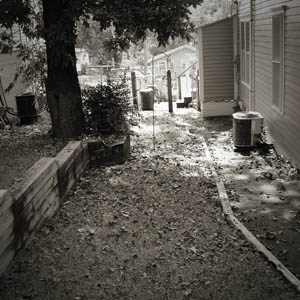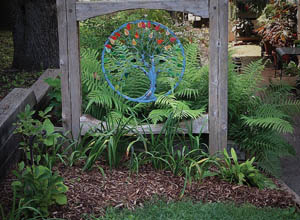
By Marcia Taylor
The women in my family have always gardened—some out of necessity (my grandmother) and some out of love (my mother). I had dabbled with gardening, usually having other priorities and not enough time to properly devote, but when my husband, Schuyler Brower, and I bought a cottage in Cotter in 2007, and moved here permanently in 2010, I decided to become a Master Gardener.
Gardening is humbling. I was used to the nice sandy soil near the river in Memphis, and our in-ground sprinkler system. Every bed I planted in Cotter—herbs here, peonies there, irises, whatever would work and not require a lot of watering while on their own—required the removal of rocks: little rocks, big rocks, native rocks, landscaping rocks. We moved buckets and buckets of rocks to replace with bags of amendments to “improve” the soil.
I bought Arkansas gardening books. I read and I studied. I learned that here rocks are the norm; bugs can be your friend; organic gardening can be harder than it sounds; and when someone tells you it’s a “bad” plant, don’t plant it.
I started digging. These were not small beds I had planned so they needed a lot of soil turning, rock pulling, grass and weed pulling. I saved those cute little bulbs that I had seen the previous three years so I could put them back in the beds as a final touch. I was on my way to becoming an Arkansas gardener.

Off to Master Gardener’s I went in October. It’s a 6-day class spread over several weeks, and my errors were immediately obvious. I learned a new technique that would have saved me the two weeks of hard labor it took to put in my front flower bed. There is a process called “lasagna gardening” that entails laying out the boundaries of a bed; laying cardboard; laying down a lot of newspaper; and putting down various layers of compost, manure, top soil, mulch, anything organic you can get your hands on. Using this method for the next bed took only eight hours. All those little “good” bugs, especially the earthworms, in the ground gobble up the grass, cardboard, newspapers, etc. and turn them into wonderful soil in about three months without nearly as much hard labor. I needed a little patience in the process.
Then there is organic gardening. I thought it was just not using chemicals: no fertilizers, no insecticides, and no herbicides. To be truly organic, the soil needs to be improved enough by composting for the plants to get sufficient nutrients to produce fruit and survive attacks from the occasional “bad” bug. So for the next two years I picked off squash bugs and squash borers by hand. I still do pick off squash bugs, but by changing my squash variety, growing it later in the season, and planting radishes next to the squash, last year was much easier.
And those little bulbs I replanted in my beds, well that is how I came to meet Deb Peterson in the spring of 2011. She and Tim were walking by my garden as I sat cursing and digging up every little Star of Bethlehem bulb I neatly planted the prior year. My learned friends in Master Gardeners advised against the Star of Bethlehem, but it was too late, they were everywhere.
The garden brings me closer to my mother and grandmother. They’ve both been gone for many years now. Mom couldn’t bear to throw away a plant, so she rooted anything that broke off; to this day I still have some of the plants she nurtured. I am reminded, too, of my grandmother every time I find big ol’ night crawlers. At her house, we always put the kitchen scraps out for the earthworms; they were great for those mornings when we went fishing. Ah, but that is another story. M! April/May 2014

Leave a Reply